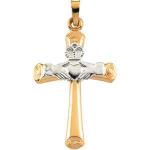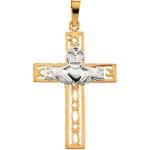Many people are familiar with the Claddagh, a traditional Celtic symbol in jewelry. The design incorporates images of two hands clasping a heart; a crown is positioned above. It can be worn in the form of a ring, cross pendant, or earrings by those who wish to indicate their Irish heritage or those who simply find the design pleasing. The Claddagh symbol has even been worn by British royalty (Queen Victoria, King Edward VII, and his consort Queen Alexandra).
The symbol of two clasped hands is a very ancient one. In ancient Rome, jewelry was fashioned with two hands joined together to symbolize faith and trust. Clasped hands also remind us of coming together as a group or being in agreement.
The heart symbol is recognized as that of love. This could be romantic love or the love of friends and family. The third symbol of the Claddagh, the crown, reminds us of the monarchy, authority, nationhood, and our duty to be loyal to our country of origin.
The Claddagh as we now know it was designed by a man named Richard Joyce. While en route to the West Indies, Joyce was himself kidnapped by pirates and sold into slavery. His new master was a Moor who was a goldsmith by trade. He found Joyce to be a most capable individual and instructed him in the art of working with precious metals.
Joyce remained in slavery until 1689 (a period of some 14 years!) when King William III successfully negotiated for their return. Despite being offered the hand of his former master's daughter in marriage (and half his property), Joyes returned to Ireland, where a young woman had been waiting faithfully for the day that he would return to her.
Joyce presented his beloved with a Claddagh ring upon his return and shortly thereafter, the couple were married. The Claddagh has become a symbol of their regard for each other: the heart for love, the clasped hands for friendship, and the crown to symbolize loyalty.



